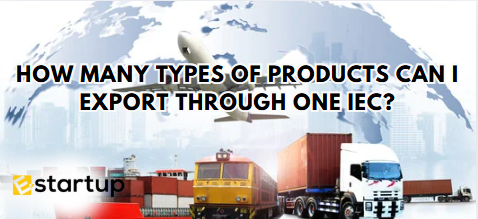
To whoever wants to try their potential in international trade in India, the Import Export Code (IEC) is the starting point. It is mandated for importers and exporters trading in India. But perhaps the most asked question by newbie exporters is: “How many types of products can I export under one IEC?”
The easy answer is – there is none. A single IEC can export different types of products. This article shall look deep into how it operates, what it has jurisdiction over, and how it supplements AD Code Registration online to ensure smooth operation of trade activities.
How Can a Single IEC Export Various Types of Products?
According to the DGFT regulations and described in Corpbiz, there is no restriction on the number of products or categories of products to be imported or exported by an IEC.
Whether you are dealing in:
- Handicrafts
- Agricultural products
- Pharmaceuticals
- Electronics
- Textiles
- Industrial equipment
- Organic products
- Processed foods
You can legally export them all under a single IEC. You do not need to apply for another IEC for every product or each category of products.
This policy offers convenience and allows diversification, especially for small businesses and startups that want to try different product lines in the global market.
Why No Restriction on Product Types Under One IEC?
The DGFT introduced this rule to make export-import norms simpler so that Indian traders have a smoother experience in the global market.
Here’s why there is ease here:
- Ease of Doing Business: The government encourages international trade through fewer regulatory requirements.
- Business Scalability: Businesses can expand and diversify products without concerns about extra licensing.
- Streamlined Process: One IEC makes compliance and documentation easy, particularly at the port and customs authorities.
- One Entity, One Code: The IEC is tied to your PAN number and serves as a sole identifier for your business.
Therefore, whether it’s 1 or 100 goods you’re shipping out, you need only to get one Import Export Code.
Things to Note When Exporting Multiple Goods
While the government permits exporting various kinds of products under a single IEC, there are a few things to note:
- Product-Specific Laws
Some products have particular licensing requirements. For example:
- Drugs and chemicals may require the Drug Controller General of India (DCGI) approval.
- Food items can be subject to a Food Safety and Standards Authority of India (FSSAI) license.
- Textile exports may necessitate Textile Committee clearance.
Always verify if your products are subject to other licenses, registrations, or clearances, even if you’re using the same IEC.
- Proper HS Codes
If you’re shipping various products, you’ll need to classify them under proper HS (Harmonized System) codes. HS codes are required for customs clearance, documentation, and understanding duty structures.
Maintaining a proper classification of products will assist in smooth functioning and prevent undue delays or fines.
How Does AD Code Registration Find Its Role?
Even though an IEC enables your company to export or import goods, it does not complete the compliance. For your shipments to be processed at ports, you must also complete the AD Code Registration.
What is an AD Code?
AD Code is an abbreviation for Authorised Dealer Code. It is a 14-digit code that your bank (Authorised Dealer bank) provides and is associated with your IEC. The code is registered with the Customs Department.
Purpose of AD Code Registration:
The AD Code is essential for:
- Registering your business at different ports (airports or seaports)
- Ensuring proper routing of foreign exchange transactions through your bank
- Enabling easy customs clearance
- Utilizing government export incentives such as duty drawback, MEIS/SEIS schemes, etc.
Can You Apply the Same AD Code to Different Products?
Yes. Like the IEC, the AD Code is also not product-specific. You may utilize the same AD Code to process financial transactions for different export products. However, you have to register the AD Code independently for every port via which your products are exported.
For example, if you’re exporting textiles via Mumbai Port and electronics via Chennai Port, you’ll need to register your AD Code in both customs ports.
Benefits of Exporting Various Products via a Single IEC
Some of the key benefits of exporting various products via a single IEC are:
- Convenience of Compliance
You don’t need to have many licenses or documents for every type of product. Single IEC makes compliance easy for multi-product traders.
- Cost-Effective
No additional expense is involved in filing for alternate codes or maintaining alternate records for alternate product classes.
- Diversification of Risk
You can reach alternate product markets and reduce dependence on one product line, resulting in higher profitability and business resilience.
- Scalability
As your business grows, you can keep adding new products to your export list without filing an additional IEC or going through an additional approval process.
Conclusion:
In summary, the Import Export Code is a general license to cover all your global trade needs once and for all. If you export one product or 50, you can have them all covered by a single IEC, provided you follow the rules of HS code classification, licensing (if necessary), and AD Code Registration at the respective ports.
Ready to expand your business internationally? Obtain your Import Export Code and register AD Code with ease through Estartup. Our professionals provide quick, secure, and cost-effective services to initiate your export process.Call us at 8881-069-069